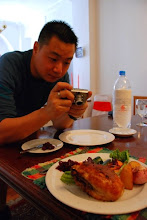Day 4: Sarawak Cultural Village (Part 1)
 11.11.2007, Sunday...Ahh! Finally, a day of rest after Francis and Asther's wedding. Now for some outdoor fun and excitement... Our next stop on the itinerary, Sarawak Cultural Village (click here to go to the official website), about 40 minutes from Kuching and 5 minutes from Holiday Inn Damai Beach Resort...
11.11.2007, Sunday...Ahh! Finally, a day of rest after Francis and Asther's wedding. Now for some outdoor fun and excitement... Our next stop on the itinerary, Sarawak Cultural Village (click here to go to the official website), about 40 minutes from Kuching and 5 minutes from Holiday Inn Damai Beach Resort...This location houses Sarawak's ethnic diversity at a glance. The handicraft is both bewildering and tempting, including the Kain Songket (Malay cloth with gold inlay), Pua Kumbu (Iban housewives textiles), Melanau Terendak (sunhat), Bidayuh tambok (basket), Iban parang (swords), Orang Ulu wood carving and Chinese ceramic. The tout ends with a 45-minute cultural performance of songs, dances and entertainment is something you will not want to miss out during your visit to Sarawak.
Entrance fee cost RM60 per adult. Package includes a 'Passport To A Most Pleasant And An Unforgettable Experience' where you can get a 'village stamp' for each cultural hut/ location you go. Pretty cool. Certainly a motivating way for you to visit the 14-acre park and all of its splendor.




Left to right: Bidayuh meeting house, where it said that warriors meet to plan attacks on neighbouring rival tribes and a Bidayuh Long house, more like a communal dorm
First up, the Bidayuh Longhouse. The Bidayuh account for approx. 8.5% of Sarawak's population and are situated within the catchment of Sarawak and Sandong rivers. Early European travellers have dubbed them "Land Dayaks" because they live in the limestone mountains in West Sarawak (used to be called 'Dutch Borneo). We were shown by a local how the Bidayuhs make blow-pipes and how they grind rice to extract the rice filling from the husks (shown above; the woman throws the rice into the air so that the wind can pull the husks away). Later, we attended a traditional Bidayuh dance, performed by the locals.


Left to right: A local showing how rice is processed and Francis, climbing out a tree-trunk stair case.

 Bidayuh women performing a traditional dance and skulls of slewn enemies of the Bidayuh in the past.
Bidayuh women performing a traditional dance and skulls of slewn enemies of the Bidayuh in the past.Next, the Iban Longhouse. The Ibans, once known as the "Sea Dayaks" built their longhouses to last 15-20 years until they exhausted the resources and farmland around their village, then move inland, upriver wherever there were fresh farm lands to harvest. About 1/3 of Sarawakians are Ibans or of Iban-origin. Typically, an Iban longhouse houses a few family rooms divided by doors with a communal walkway where the inhabitants could congregate. The Iban celebrate Gawai (harvesting festival) after having a bumper crop and would indulge in "tuak" (locally-brewed rice beer).




Left to right (clock wise): (1) A B&W rendition of the tools and materials used by Iban women to make a shoulder scarf, typically seen on Iban women during Gawai festiwals (Harvesting festival) (2) the interior of an Iban Longhouse, (3) Iban people in the Longhouse and (4) an Iban woman doing a dance for us
Next up, the Penans, nomadic and shy people who live in the dense virgin jungles of Central Borneo (click here). Penans' speciality is the manufacturing and accurate use of blow-pipes(click on the link) We were given a shot at it. I got 3 tries, one was near the bullseye, one missed completely and the last one hit a soda can spot on!!!! It's not easy to aim, especially if you have to hold the weapon at the very tip near your mouth, supporting the whole weight with your left biceps... Mike Tjoa (below)'s try was not too shabby for a virgin hunter!!


Left to right: A Penan host teaching us the proper techniques when executing a blow-pipe and Mike Tjoa giving a blow ..:)
To be continued...
Labels: Vacation


0 Commentsjavascript:void(0):
Post a Comment
<< Home